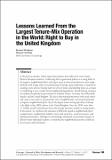Files in this item
Lessons learned from the largest tenure-mix operation in the world : right to buy in the United Kingdom
Item metadata
| dc.contributor.author | Kleinhans, Reinout | |
| dc.contributor.author | Van Ham, Maarten | |
| dc.date.accessioned | 2015-05-11T12:01:03Z | |
| dc.date.available | 2015-05-11T12:01:03Z | |
| dc.date.issued | 2013 | |
| dc.identifier | 176257416 | |
| dc.identifier | 4502a275-05d8-4c47-8ecb-5ba2b4596c9b | |
| dc.identifier.citation | Kleinhans , R & Van Ham , M 2013 , ' Lessons learned from the largest tenure-mix operation in the world : right to buy in the United Kingdom ' , Cityscape: A Journal of Policy Development and Research , vol. 15 , no. 2 . | en |
| dc.identifier.other | ORCID: /0000-0002-2106-0702/work/64697516 | |
| dc.identifier.uri | https://hdl.handle.net/10023/6629 | |
| dc.description.abstract | In the past few decades, urban regeneration policies have taken firm root in many Western European countries. Underlying these regeneration policies is a strong belief in the negative neighborhood effects of living in areas of concentrated poverty, often neighborhoods with a large share of social housing. In Europe, great importance is attached to creating a more diverse housing stock (in terms of tenure and dwelling types) as a means to establishing a more socially mixed neighborhood population. Mixed-housing strategies are embraced explicitly by governments in Finland, France, Germany, the Netherlands, Sweden, and the United Kingdom. The idea is that mixing homeowners with social renters will create a more diverse socioeconomic mix in neighborhoods, removing the potential of negative neighborhood effects. By far the largest tenure-mixing operation in Europe is the Right to Buy (RTB) scheme in the United Kingdom. Since the 1970s, more than 2.7 million socially rented houses have sold at large discounts, mainly to sitting tenants. In this article, we synthesize the outcomes of RTB with regard to neighborhood effects: residualization, neighborhood stability, tenure and social mix, social interactions, and dwelling maintenance. Although we acknowledge substantial socioeconomic benefits of RTB for many individual residents, we find that the neighborhood outcomes of RTB are by no means solely beneficial. | |
| dc.format.extent | 176415 | |
| dc.language.iso | eng | |
| dc.relation.ispartof | Cityscape: A Journal of Policy Development and Research | en |
| dc.rights | Copyright 2013 HUD. This article was originally published by the U.S. Department of Housing and Urban Development, Office of Policy Development and Research, and is reproduced here with the Department's permission. | en |
| dc.subject | GF Human ecology. Anthropogeography | en |
| dc.subject | SDG 11 - Sustainable Cities and Communities | en |
| dc.subject.lcc | GF | en |
| dc.title | Lessons learned from the largest tenure-mix operation in the world : right to buy in the United Kingdom | en |
| dc.type | Journal article | en |
| dc.contributor.institution | University of St Andrews.Geography & Sustainable Development | en |
| dc.description.status | Peer reviewed | en |
| dc.identifier.url | http://www.huduser.org/portal/periodicals/cityscpe/vol15num2/article7.html | en |
This item appears in the following Collection(s)
Items in the St Andrews Research Repository are protected by copyright, with all rights reserved, unless otherwise indicated.

